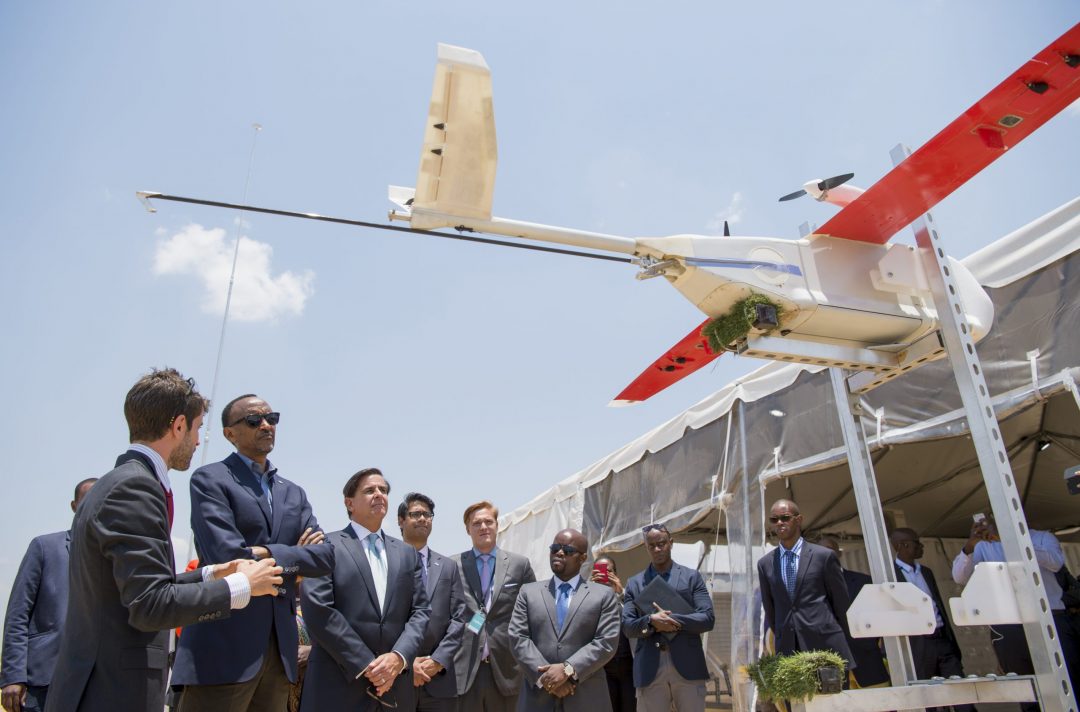Executive Summary
Rwanda’s mountainous topography makes ground transportation of medical supplies unreliable — some roads stretching into rural areas remain uncared for and unpaved. Between 25 and 40 per cent of all temperature-sensitive medical supplies sent from urban centres to rural health clinics are wasted because of an unreliable cold-chain infrastructure. Rural clinics are also often subject to stockouts, and patients in need of specialized blood products, drugs and other supplies are unable to acquire them. Zipline, a US-based health logistics company, aims to address the issue of access to medical supplies, largely leapfrogging traditional modes of transportation and various obstacles. Zipline uses drones to deliver blood and other routine and emergency medical supplies from distribution centres to district hospitals and rural health centres.
Although the company has been celebrated in the media for its operations, there is little scholarly work on its operations and performance. This has led to some confusion over its scale. We aimed to gain insight into the details of Zipline’s business model, including the infrastructure, regulations and government support that make Zipline possible, and to understand its impact on health outcomes in Rwanda. Our work was entirely based on published materials since our research was conducted during the COVID-19 pandemic.
Healthcare Context
Renowned for its mountainous landscape, Rwanda is a relatively small country in central Africa that stretches over a surface area of 26,338 square kilometres.1 2
The healthcare system is mostly publicly funded and operated, and includes national referral hospitals, district hospitals, health centres, dispensaries, community health posts and community health workers. Many of these facilities are located in rural areas, where health centres deliver most primary care. As of 2018, there were 465 health centres in Rwanda, each serving an average catchment population of approximately 20,000 people.3 4
Health outcomes spanning numerous indicators had already dramatically improved prior to Zipline’s involvement. For example, the decrease in maternal mortality rates is a testament to Rwanda’s commitment to improving its healthcare system — the country went from having 1,160 deaths per 100,000 live births in 2000 to 260 in 2016.5
Despite the progress, numerous challenges remain. A 2015 paper found that residences over five kilometres from health centres were more likely to experience negative health outcomes. At the time, only 43 per cent of health centres were within an hour’s walking distance from health centres, highlighting that Rwanda faces issues with its transportation infrastructure and/or housing units being too far from health centres.6
Poor road infrastructure in the mountainous landscape and a lack of road maintenance render cold-chain delivery of medical supplies unreliable. According to the Ministry of Health, between 25 and 40 per cent of all temperature-sensitive medical supplies sent from urban centres to rural health clinics are wasted because of the unreliable cold chain.7 Rural clinics are often subject to stockouts, and patients in need of specialized blood, drugs and other supplies are unable to acquire these supplies.8 9
The ability to transport blood quickly is critical because a patient experiencing massive blood loss can deplete the supply of a small-to-medium hospital while larger hospitals might not have enough supply of certain blood types. 10
Rwanda’s Supply Chain
Rwanda’s health system is characterized by a hierarchical structure. Its apex is the Ministry of Health which regulates the operations of all public and private facilities in the country. Decentralized institutions in the system include the province-, district-, sector-, cell- and village level organizations with responsibility for the provision of health services.11
The Medicine Procurement and Production Division (MPPD) of the Ministry of Health manages the procurement, forecasting and distribution of medical supplies. Serving as a warehouse, the MPPD supplies medical products to district pharmacies and referral hospitals. District pharmacies, in turn, distribute products to health centres and district hospitals. Patients access medical services from health centres, district hospitals, community health workers, private hospitals or referral hospitals, depending on the level of care they require. The Logistics Management Office (LMO) works with the MPPD to direct supply chain functions. The Ministry of Health oversees and supervises all activities. (See Figure 1 for details.) Zipline, as a healthcare logistics company, is situated between the MPPD (i.e., the supplier) and health facilities (i.e., health centres, district hospitals, health posts and community health workers), acting as a bridge between both parties.
Figure 2. Rwanda’s Supply Chain Network. Arrows represent commodity flows. (Source: “Rwanda NSCA and Pharmaceutical Supply Chain Strategic Plan Technical Report.
Drones in Medicine
In recent years, drones have emerged as a popular solution to development and humanitarian challenges. Drones can deliver goods in four broad categories: retail goods, food, medical and industrial goods, each with its own unique social, legal and regulatory challenges at different stages. The most popular uses are in agriculture, the environment, conservation and medicine. 12 . 13 14
Reaching Rural People
In 2019, Rwandans residing in rural areas accounted for 82.69 per cent of the total population, and some have struggled to maintain constant and reliable access to vital medical supplies.15 16 17
Examining vaccination campaigns, Sachiko Ozawa and colleagues define hard-to-reach populations as “those facing supply-side barriers … due to geography by distance or terrain, transient or nomadic movement, healthcare provider discrimination, lack of healthcare provider recommendations, inadequate vaccination systems, war and conflict, home births, or other homebound mobility limitations, or legal restrictions.”18
About Zipline
In Rwanda, Zipline’s primary activity is the fast delivery of blood and other emergency medical supplies via drones. Cooperating with the Civil Aviation Authority, the company has a unique ability to complement or replace existing delivery networks. Zipline also has expertise in product handling and management. It offers solutions for emergency response and on-demand delivery for medical supplies. It has also played a role in responding to COVID-19 health needs.19 20 21
Governance and Stakeholders
Zipline has partnerships with key players in the regulation and medical-procurement space in Rwanda. The National Centre for Blood Transfusion (NCBT), a division of the Rwanda Biomedical Centre (RBC), collects blood from volunteers through regional centres for blood transfusion. The NCBT has 568 collection sites and five regional distribution sites across the country, all located in administrative provinces and in Kigali. By 2018, the NCBT was collecting approximately 60,000 blood units each year.22
Once it has collected donations of blood, the NCBT transports the blood products to Zipline by truck. The NCBT is the key contributor to Zipline’s blood supply as well as other medical products. According to Dr. Jean-Baptist Mazarati, the head of the Department of Biomedical Services (including the NCBT), Zipline also acquired land for its distribution centres as well as government assistance with the required technology to operate the distribution centres. The Rwandan government pays Zipline a fixed price per delivery, with a minimum volume guarantee. However, the specifics of this arrangement have not been disclosed.
The Ministry of Health (MoH) is involved with Zipline on a broad administrative level. In addition to being responsible for the NCBT, the MoH was closely involved with the negotiations and the development of the contract between Zipline and the Government of Rwanda. According to a student interview reported in a Harvard Business School case, Nicholas Hu, a managing director at Zipline in California stated that the MoH also helps establish the products and product quantities that the company needs to deliver.22
The next major stakeholder is the Rwandan Civil Aviation Authority (RCAA), which takes on the management, operation and maintenance of airport infrastructure. Before medical products are launched, Zipline performs a pre-flight quality assurance on the drone, confirms its flight plan with the RCAA and requests flight clearance. Once the drone is catapulted, it is fully autonomous. Both Zipline and the RCAA track the drone’s path and can redirect it through the country’s wireless network.
Zipline benefits from having many donors including the UPS Foundation and the GAVI vaccine alliance. The company aims to eventually add donors such as the Bill and Melinda Gates Foundation, Goldman Sachs, Toyota Tsusho Corp and more. In 2018 and 2019, donors helped Zipline raise USD 190 million in new financing which boosted its valuation past USD 1 billion.23
Figure 2. Medical supplies delivered by drone. (Photo courtesy of Paul Kagame).How it Works
Zipline operates from two distribution centres located in Muhanga and Kayonza, cities located west and east of Kigali respectively. The layout facilitates the work that goes into delivering medical supplies. For example, inside the Kayonza-based distribution centre, there are three main operating rooms: a control tower where drone movement is monitored for safety reasons, a warehouse where blood stocks are kept, and a flight operations centre. These operating rooms work in tandem to store medical supplies, prepare supplies for delivery and execute delivery as fast as possible.
Blood is centrally collected in Kigali in partnership with the NCBT and delivered to Zipline’s distribution centres in refrigerated vehicles. The products then become available for distribution to district hospitals and other community-level health centres. Prior to accepting orders for medical supplies from physicians, Zipline forms relationships with health centres and hospitals within its service radius. Zipline’s community outreach staff create awareness about Zipline’s operations in communities that need and are eligible for the delivery service.
The delivery process involves several steps. First, health personnel at clinics and hospitals submit orders to Zipline for the medical products they need via SMS, WhatsApp or phone call. Medical products, which are centrally stored at the Zipline distribution centres in ultra-cold storage, are packaged and prepared for flight, maintaining cold-chain and product integrity. Once Zipline packages the order, they catapult the products on a cargo drone that travels up to 160 kilometres per hour once in the air. Drones fly rain or shine over mountains, bodies of water and washed-out roads. Within minutes of the drone’s departure, health workers receive confirmation that their order has launched. Upon arrival at their destination, medical products are delivered gently by parachute into a pre-designated area the size of a few parking spaces. Hospital staff are notified via text message of the delivery.
Zipline uses what is called a fixed-wing drone model, which is best for covering longer distances and carrying heavier loads.24 25
Evaluating Success
Although a comprehensive and authoritative review of Zipline’s impact on health outcomes in Rwanda is not currently available, numerous sources have corroborated the information that the company showcased, focusing on its success in reaching hard-to-reach communities and increasing access to blood products for all Rwandans.
At the beginning of 2020, Zipline was delivering over 75 per cent of Rwanda’s blood supply outside of the capital, Kigali.26 27 28
Anecdotal evidence points to the fact that the reduction in delivery times can have tremendous impact on health outcomes, especially in emergency situations. For example, having access to blood in maternity wards can dramatically increase the chances of survival for both mothers and newborns. Rwanda had already made impressive strides in decreasing maternal mortality, going from 1,160 deaths per 100,000 live births in 2000 to 260 in 2016 when Zipline began its operations.29 17 30
Conclusion
Lessons Learned
Partnership with the Public Sector
Engaging and partnering with local stakeholders via a public-private partnership has been essential to Zipline’s success. The company has relied on the flexibility of the RCAA in updating its regulations to address the presence of unmanned aerial vehicles in aerial space.
Similarly, the collaboration with the Rwandan Biomedical Centre ensured that Zipline is not solely responsible for procuring essential medicine and conducting quality assurance controls. This frees the company from significant logistical burdens. Without such support, Zipline’s venture into Rwanda and Ghana might have been unsuccessful from lack of government buy-in.
Figure 3. Zipline CEO Keller Rinaudo leading the tour of the medical drone facility, Muhanga, October 14, 2016. Regulatory and Technical Hurdles
Zipline currently operates in Rwanda and Ghana, both relatively small countries. If the company intends to scale operations to larger countries, it will have to overcome a number of regulatory and technical hurdles. This means that drones must reach their destinations without falling, without causing harm and by landing safely in the event that they are unable to reach their destination. The drones must avoid collisions with power lines, buildings, trees and other aircraft.31
Intergration into Supply Chain
Zipline’s service was well integrated into the medical supply chain. The company filled a substantial gap in Rwanda’s health care logistics. It did not create a parallel delivery structure through which blood and other medical products can be delivered; rather, it supplemented and strengthened the government’s existing capabilities to reach its citizens.
Scale is Essential to Keep Costs Low
The costs of purchasing, building and maintaining infrastructure, as well as of operating drones, can in 2017 that Zipline drones could reduce net cost in emergencies but were more expensive than traditional methods when used for restocking purposes.32 33
Comparing Investment for Long-Term Impact
Prior to committing to setting up a drone delivery system that is both complementary and potentially disruptive to traditional alternatives, it is important to consider the opportunity cost of sidelining traditional alternatives. Foregoing investments in roads could have an impact on other important social and economic indicators. Matternet, a California-based drone company, estimated the costs of building 50 base stations and operating 150 drones at USD 0.24 per flight throughout the city of Maseru in Lesotho. A back-of-the-envelope analysis suggests that drone delivery would be more cost-effective than the USD 1 million it would take to build a two-kilometre one-lane road.34
Understanding Rural Needs
Zipline appears effective in increasing access to medical supplies. However, improving health outcomes goes beyond access. To determine impact, we must better understand the needs of patients in rural communities and the implications for health system development, including the availability of trained medical personnel and technical equipment. In short, while Zipline can guarantee that blood can be made available, it is unclear whether trained physicians and transfusion machines will be available to ensure the appropriate administration of blood. Therefore, to determine impact, careful consideration of the medical environment should be undertaken.
While reports indicate that the National Centre for Blood Transfusion (NCBT) provides access to blood through Zipline, an outstanding question arises regarding whether district hospitals offer blood transfusion services. In 2005, we learned from Rwanda’s Service Availability Mapping survey that 12 districts had reported not offering these services. Of those that did offer these services, 28 per cent reported interruptions in their blood supply.35
Limitations to Research
Our team originally planned to travel to Rwanda to obtain evidence on Zipline’s impact from pharmacists, physicians and administrators. We also planned to visit the company’s distribution site in Muhanga. However, because of the COVID-19 pandemic, the Rwandan government closed its borders to foreigners to curb the spread of the virus and prioritized COVID-related projects for consideration under its Institutional Review Boards for Research Ethics Approval. We therefore had to find a different approach.
Our first instinct was to conduct interviews with Rwandan personnel in Zipline, the Ministry of Health and other organizations, but we had to abandon this approach because we were unable to apply for the required local Research Ethics Board approval from each of the three ethics boards in Rwanda: National Council of Science and Technology (NCST), National Ethics Committee (NEC) and the National Health Research Committee (NHRC) due to complications from the COVID-19 pandemic.
As a result of these obstacles, the team continues to have unanswered questions about Zipline’s activities in Rwanda. Some of the questions involve:
Cost: What is the cost per delivery? How is Zipline’s contract with the government of Rwanda structured and enforced? Service availability: How widely available are Zipline’s services across Rwanda?Data : What kinds of data are collected? Who has access to the data? Products and flexibility: What flexibility does Zipline have in delivering medical products outside the government-mandated products
Impact : How significant has Zipline’s impact been on the health of hard-to-reach populations in Rwanda?
Acknowledgments
This research was made possible through the Reach Alliance, a partnership between the University of Toronto’s Munk School of Global Affairs & Public Policy and the Mastercard Center for Inclusive Growth. Research was also funded by the Ralph and Roz Halbert Professorship of Innovation at the Munk School of Global Affairs & Public Policy. We express our gratitude and appreciation to those we met and interviewed. We thank former Project Officers Siddhartha Sengupta and Anushree Warrier for their guidance in the early stages of the project. We are also grateful to Professor Anita McGahan for her mentorship through this research project.
This research was vetted by and received approval from the Ethics Review Board at the University of Toronto. Research was conducted during the COVID-19 pandemic in compliance with local public health measures.
MASTERCARD CENTER FOR INCLUSIVE GROWTH
The Center for Inclusive Growth advances equitable and sustainable economic growth and financial inclusion around the world. The Center leverages the company’s core assets and competencies, including data insights, expertise, and technology, while administering the philanthropic Mastercard Impact Fund, to produce independent research, scale global programs, and empower a community of thinkers, leaders, and doers on the front lines of inclusive growth.
MUNK SCHOOL OF GLOBAL AFFAIRS & PUBLIC POLICY
The Munk School of Global Affairs & Public Policy at the University of Toronto brings together passionate researchers, experts, and students to address the needs of a rapidly changing world. Through innovative teaching, collaborative research, and robust public dialogue and debate, we are shaping the next generation of leaders to tackle our most pressing global and domestic challenges.







